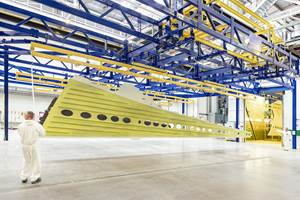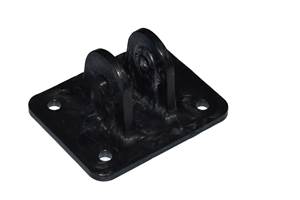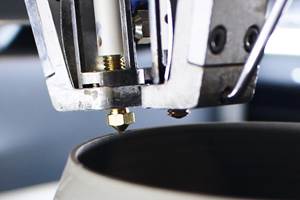The AAMMC Tech Hub: Ramping U.S. production of large thermoplastic composite aerostructures
CW talks with Syensqo, Spirit AeroSystems and other consortia members about current funding, specification of the next world’s largest press, organizational structure and projects to support U.S. companies in the race to deliver >40,000 sustainable and efficient aircraft over the next 20 years.
The AAMMC Tech Hub will advance U.S. production of large thermoplastic composite (TPC) aerostructures like this fuselage panel demonstrator from the HAICoPAS project, as well as wing ribs and engine nacelles, the latter part of Collins Aerospace's roadmap for TPC structures. Source | CW, Collins Aerospace and aerospacetechhub.com
The American Aerospace Materials Manufacturing Center (AAMMC, ) is one of 31 regional tech hubs funded by the U.S. Economic Development Administration (EDA). Located in the Spokane-Coeur d’Alene region spanning eastern Washington and northern Idaho, the AAMMC will advance large thermoplastic composite (TPC) structures for defense and commercial aircraft to technology readiness levels (TRL) 6-9.
While U.S. industry has proven the reduced cost and weight of TPC in both commercial and defense applications, it lags behind other nations, currently lacking the infrastructure to meet domestic demand and to compete globally for high-rate fabrication.
Source |
The AAMMC Tech Hub will address this and be the only site in the world with all necessary tools and equipment under one roof to accelerate certification and production of large TPC aerostructures. It will also create and support new supply chains for high-rate production of such parts in the U.S., enabling domestic companies to catch up to global competitors.
The AAMMC Tech Hub will be housed in a repurposed 386,000-square-foot former manufacturing facility on 50 acres adjacent to the Spokane International Airport.
Consortium and funding
Source | AAMMC Tech Hub
The AAMMC Tech Hub is supported by a spanning the complete value chain for TPC aerostructures as well as national laboratories and educational institutions, governments including local, regional and tribal entities and organizations to implement venture, workforce and economic development.
Although the AAMMC did not receive any funds during the distribution of $480 million in grants to 12 designated Tech Hubs in July 2024, it is expected to receive more than $50 million in funding as part of additional EDA funding distributed in January 2025. This funding will comprise the federal award, as well as industry and private commitments.
The AAMMC’s 5-year budget proposal includes $72 million in federal funding with $8 million in matching funds from industry partners such as Boeing, Collins Aerospace, Spirit AeroSystems, Syensqo and Toray Industries, along with venture capital from Lakeside Companies. There is also substantial financial and policy investment from various entities including Gonzaga University, Washington Trust Bank, Mountain West Bank, The Spokane International Airport, S3R3, The City of Spokane, Accudyne Systems, ATC Manufacturing and many others.
Meeting demand
Source |
Source |
In 2024, Boeing projected that 44,000 aircraft will be needed by 2043, including more than 33,000 single-aisle jetliners. — 42,000 aircraft over the next 20 years. Unfortunately, aircraft production rates have plummeted post-COVID, with the that aircraft deliveries remain 30% below their pre-pandemic peak, resulting in an unprecedented global backlog of 17,000 aircraft — equivalent to ~50% of the current fleet — far exceeding the historical norm of one-third.
At current production levels, OEMs will require 13.5 years to clear the existing backlog — i.e., aircraft ordered today may not be delivered until nearly 2040. The AAMMC Tech Hub has been established to help address this shortfall.
World’s largest press
Mark Wadsworth, senior composite research engineer, advanced composites R&T for Spirit AeroSystems (Wichita, Kan., U.S.), explains the current lack of large TPC structure capabilities in the U.S. “Right now, we have to go outside the U.S. to get large parts stamped. The Tech Hub’s goal is to have a press that is larger and more capable than the one recently installed at Airbus Bremen, for example, in order to accommodate development and certification of the large-sized TPC parts in the U.S. needed for the next generation of aircraft. This press will be the longest lead-time item, requiring 2-3 years for design, manufacture and installation.”
“We are now in the process of developing the press equipment specification,” adds Govind Raj, senior manager advanced composites for Spirit AeroSystems in the U.S. “The AAMMC will then issue the RFQ, assign the contract and have it shipped to the site in Spokane for installation.”
Each piece of equipment needed for the AAMMC will require such a specification. This currently includes automated fiber placement (AFP) equipment, ovens for out-of-autoclave consolidation and nondestructive testing (NDT) equipment, among others. “We will develop specifications for these equipment as well,” adds Raj.
Operational structure, projects
In the meantime, the founding members continue to advance planning for projects and collaboration. The AAMMC Tech Hub structure includes a governing board and technical board that coordinate to propose projects and invite members to respond to participate, similar to how the pan-European Clean Aviation program announces projects and issues calls for proposals (CfP).
“The Tech Hub site will be operated by a handful of highly qualified core technicians and staff,” says Raj. “Each consortium member that participates in a project will send their own technicians to complete the work packages they are assigned. We don’t envision this as a pre-competitive R&T center but instead everyone will be able to partner and/or complete their work in separate, IP-protected spaces as necessary.”
“The facility is very flexible and can easily accommodate this type of operation,” notes Chris Pengra, executive director of S3R3 Solutions, a Spokane-based economic development organization.
Materials suppliers
“This is the first manufacturing center of its type in North America,” points out Fabrizio Ponte, EVP head of thermoplastic composites at Syensqo. “Our vision is to have a more collaborative technology center like many established in the EU. This Tech Hub will see unprecedented collaboration between Boeing as an OEM with multiple Tier 1s and suppliers throughout the value chain. This is already remarkable and unique in the U.S. and will enable acceleration of domestic large TPC aerostructures production — something that has been long promised but not yet realized. We will now have the capability to demonstrate and certify this technology for next-gen commercial and defense applications. No one in the U.S. can press large wing ribs, door and fuselage structures without this large press, which is our first and longest-lead investment.”
Syensqo’s APC thermoplastic composite tape. Source | Syensqo
Syensqo supplies a range of advanced TPC matrix systems including PEEK, PEKK, PAEK and PPS. “Boeing has used TPC for a long time but only for interiors and small parts,” adds Ponte. “I think we need to make sure the U.S. aerospace industry is ready and capable for the high-rate and sustainable production possible with larger TPC structures.”
Materials supplier Toray Advanced Composites (Morgan Hill, Calif., U.S.) is also a consortium member. Raj notes: “All of these member companies are competing but this Tech Hub brings them together and strengthens their capabilities.”
Training, workforce development
Another key part of the AAMMC Tech Hub is training and workforce development. Gonzaga University is the lead higher education institution and the University of Washington in Seattle is also a key consortium member with a long track record in composites development for Boeing and the aerospace industry. “We also have North Idaho College in Coeur d’Alene,” notes Pengra, “which offers a composites technician program for the aerospace industry. We have a robust selection of workforce training organizations that will contribute to the Tech Hub, and they are collaborating well.”
“The operating plan that we are developing will address how the different educational and workforce development organizations participate and share in AAMMC Tech Hub projects,” adds Raj.
Required systems, continuum of support
“It’s all about producing
lightweight aircraft at rate.”
“The required focus and support systems are in place in this Tech Hub to make its members successful,” agrees Pengra. “We’re listening to manufacturers and making sure that education and workforce programs are in place and designed to meet their talent needs.”
“The airport has land that’s ready for development to support the long-term goal of a full supply chain for the high-rate production of TPC aerospace parts,” notes Todd Woodard, director of public affairs for the Spokane International Airport, adjacent to the AMMCC Tech Hub facility. “Both the Washington and Idaho state governments are working together to realize this vision, with their four U.S. Senators aligned, as well as multiple cities and counties. It took 2 years to put the AAMMC Tech Hub proposal in place, and now that we have been selected and received initial funding, we are even more committed to acceleration of this technology and certification of parts.”
“The consortium has identified the processes and materials that will be involved and developed the list of capabilities and equipment based on needs,” says Raj. “Each member has a specific technology roadmap.” For an example, see “The potential for thermoplastic composite nacelles.”
“Most of us are in the HiCAM project as well,” adds Wadsworth. He is referring to , aimed to address the need for more rapid production of composite aircraft to meet increasing global demand for lightweight transport aircraft. “That project, however, targets advancing multiple technologies to TRL 4. This Tech Hub will push to TRL 5 and higher. So, we effectively now have a continuum from HiCAM forward that will accelerate TPC adoption and capacity. It’s all about producing lightweight aircraft at rate.”
Related Content
Plant tour: Spirit AeroSystems, Belfast, Northern Ireland, U.K.
Purpose-built facility employs resin transfer infusion (RTI) and assembly technology to manufacture today’s composite A220 wings, and prepares for future new programs and production ramp-ups.
Read MoreThe potential for thermoplastic composite nacelles
Collins Aerospace draws on global team, decades of experience to demonstrate large, curved AFP and welded structures for the next generation of aircraft.
Read MoreHybrid process marries continuous, discontinuous composites design
9T Labs and Purdue applied Additive Fusion Technology to engineer a performance- and cost-competitive aircraft bin pin bracket made from compression-molded continuous and discontinuous CFRTP.
Read MoreA new era for ceramic matrix composites
CMC is expanding, with new fiber production in Europe, faster processes and higher temperature materials enabling applications for industry, hypersonics and New Space.
Read MoreRead Next
Plant tour: Collins Aerospace, Riverside, Calif., U.S. and Almere, Netherlands
Composite Tier 1’s long history, acquisition of stamped parts pioneer Dutch Thermoplastic Components, advances roadmap for growth in thermoplastic composite parts.
Read MoreAAMMC aerospace tech hub earns $50 million in funding
Federal funding, as well as industry and private commitments will establish a test bed for aerospace composite materials in the Pacific Northwest with industry partners like Boeing, NASA, Collins Aerospace, Toray, Syensqo and more.
Read MoreA legacy of innovation in advanced thermoplastic composites
ATC Manufacturing, a 2024 Top Shops honoree, enables high-rate aerospace production with sustainable, lightweight and durable thermoplastic composite solutions.
Read More














